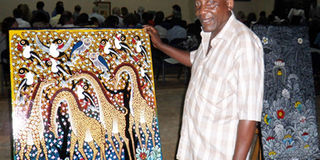Earning a living from painting

Mzunguno with some of his works at an art exhibition in Kampala recently. PHOTO BY SANDE BASHAIJA
If you love art, then you can’t help but fall in love with David Mzuguno’s work. He calls himself a naïve artist, one that needed no extensive training at school to become a specialist in painting.
“I started doing it as a hobby, just for fun but it’s now a job,” the Tanzanian artist, who has charmed hearts in Denmark, China and Japan with his paintings, says. The 59-yer-old staged an exhibition at International School of Uganda (ISU).
With pieces that capture nature’s beauty including forests and wildlife, many local artists and art lovers were left in awe at Mzunguno’s exhibition opening ceremony at the ISU Lubowa campus on a March 13 Saturday evening.
“His works are simply amazing,” Pascal Bogaert, an artist and teacher at ISU commented in recognition of Mzuguno’s skills. The theme of Mzuguno’s work hinges around African culture, the type of art started by another Tanzanian Eduardo Saidi Tingatinga (RIP). Mzunguno quit school after completing Form Four at Azania Secondary School in Tanzania but had no idea of what life would be like thereafter.
“I had won several painting awards in school but never had it in mind that I would make a living from drawings,” he recalls. After leaving school, Mzunguno tried out his hands on casual jobs in Kenya's Health Ministry but still continued to do art on a part-time basis.
“In 1968, I decided to quit my job and concentrated on painting.” He teamed up with Tingatinga, establishing an art studio that has turned him into a millionaire and celebrity of sorts. When Tingatinga was accidentally shot dead by policemen in 1972, Mzunguno established himself as the king of art in Tanzania. “Together with two other colleagues, we are called the masters of Tingatinga art,” he says with a broad smile. Even with the other two masters; Geoerge Nyama and Boniface Msagula offering some kind of competition in the business, Mzunguno shines brightest.
Over the years, he has established galleries in Zanzibar, Arusha and Dar es Salaam. Standing beside him during this interview, cutting an appearance of a bodyguard is Hussein Mukwilu. More eloquent and confident in speech, the 63-year-old introduces himself as a brother to Mzunguno. “He is the one who taught me how to do art,” Mukwilu says, “I am not anywhere near him in terms of class but I can confidently say that I am good.” Like Mzunguno, Mukwilu also quit his job and started doing art on a fulltime basis. “I have also taught three of my children to do art and hopefully they will carry on with the business when I have left this world,” Mzunguno says.
So is this art business worth giving a try or quitting a decent government job for? If you are assured of earning like Mzunguno, taking on art is the best option. According to the price list at his ISU exhibition, the cheapest piece goes for $100 (about Shs200,000). To take home a piece standing at 110x241 centimetres, you’ve got to part with $1,200 (about Shs2.4m).
Yet, according to ISU teacher Bogaert, Mzunguno’s galleries are ever empty because of the overwhelming demand. “I have known him for some time and this is the only time he has had a big collection of work. Every time he finishes a piece, it is bought immediately,” Bogaert says. Though Mzunguno carried more than 80 pieces at the ISU exhibition, he is sure of returning home "empty-handed". For the Tanzanian, this is clearly a lucrative business although he feels uncomfortable disclosing his earnings.
“By the end of the year, we can make a profit of $25,000 (Shs50m),” Mzunguno says after extensive consultations with his brother. The price of being celebrated painter is, however, taking a toll on his life. “Right now, I feel very fatigued. Yet from here I won’t be taking a rest. I have to connect to Dubai where I have been asked to paint a mural at some hotel,” he reveals. “But I am now used to that kind of life.”
Mzunguno started globe-trotting in 1980, his first stop being in Copenhagen, Denmark where he participated in an exhibition at the African Image Gallery. In 1995, he penetrated into the Japanese market. He has taken part in several university exhibitions and won an award for the best African artist in China last year. The father of 13 says, he always tries to send out a message in every work he does.
“I was born in the Kilimanjaro region at a time when the environment was jealously safeguarded. Nowadays, it’s being degraded. I hope my works can inspire people to conserve the environment.”




